Measurements with analog video camera WAT-902H2 Ultimate
| Frameless version of this page |
Pages of the EXTA project
Page #1 - Main page with EXTA description
Page #2 - Measurements with analog video camera modul SK1004XC
Page #3 - Measurements with analog video camera WAT-902H2 Ultimate (this page)
Page #4 - Measurements with integrating analog video camera WAT-120N
Page #5 - Measurements with Astro CCD camera Atik 314L+
Page #6 - Measurements with IOTA-VTI device
Page #7 - Measurements with integrating analog video camera MINTRON 12V1C-EX
EXTA measurement setup for analog video camera WAT-902H2 Ultimate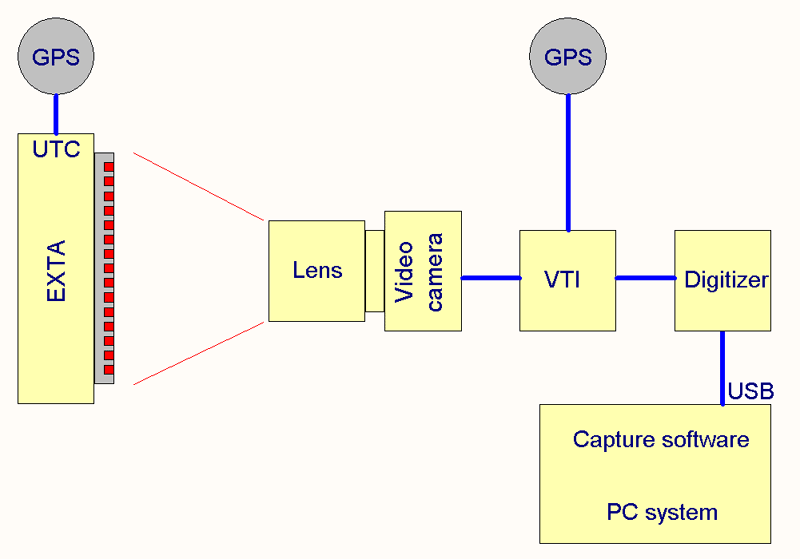
The source for the time stamps in the video images was the VTI KIWI-OSD which was synchronized to UTC with NMEA 0183 data sentences and 1 PPS signal of a Garmin GPS 18x LVC sensor. The digitizer used was a DFG/USB2-lt Videograbber device from The Imaging Source. The videograbber was connected via USB2.0 to a notebook running with a XP32 system. The capture software was VirtualDub. The CCIR video file was recorded uncompressed and lossless in Y800 format and in container format AVI direct to the harddisk.
Full frame video image from camera WAT-902H2 Ultimate
CCIR video image with KIWI-OSD video time insertion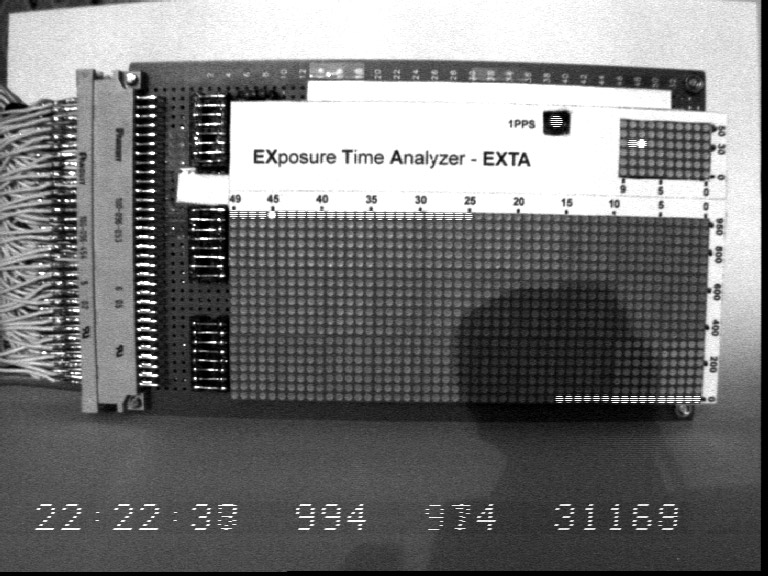
In this full frame CCIR video image above with video time insertion we can see on the right top seconds LED matrix that the exposure started in UTC second 37 and ended in the 38th second. The same UTC seconds were inserted by the KIWI-OSD VTI in numbers on the bottom of the video frame. EXTA was set to mode 0 so every LED in the big LED matrix corresponds to 1ms. The exposure startet in the 975th millisecond in the UTC second 37. The end of the exposure can be seen in the 15th millisecond of UTC second 38. If we count all the lit 1ms LEDs we get 41. But if we take a closer look at the LEDs we can see that the first LED of the lit row is a little bit smaller than the others between them. So we can assume that this LED was not exposured for a full millisecond. And the over all exposure time may be a little bit over 40ms but surely not 41ms. This result matches with a full length exposured CCIR video frame.
Now if we compare the times measured by EXTA 37.975 - 38.015 and the times 37.974 - 38.014 inserted by the Video Time Inserter KIWI-OSD we can see a difference of about one millisecond. What is the reason for this difference? The answer is a time shifted output signal of the video camera. The start of the optical exposure is nearly one millisecond late to the output signal of the previous field with Vsync. And because this VTI and most others too are time stamping the video fields triggered by the Vsync we get times shifted by nearly one millisecond. So this time shift is not caused by the VTI device and was also measured by me with my other measurement device VEXA some years ago. But this relative small time shift is absolutely no problem in normal occultation work.
One another detail which is remarkable in the measurement image above. The lit LED numbered with 995 does not shop stripes like the other do and so looks more brightful. The answer is given if we take a look on this video image with both fields separated as shown below.
The same video image split in both fields
Both fields of CCIR video image with video time insertion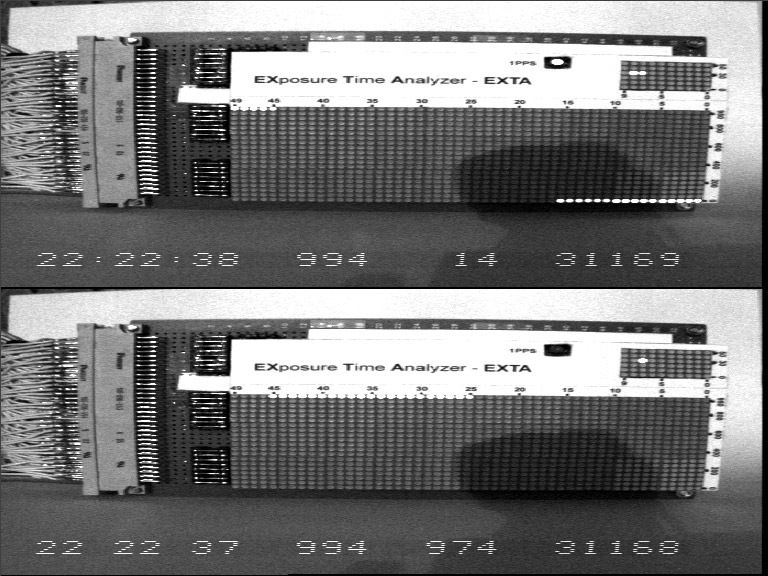
Now both field exposure times are clear visible. The first field #31168 is exposured from 37.975 - 37.995 and the second field #31169 from 37.995 - 38.015. And we can see that the lit LED #995 is captured for a short time at the end/start in both fields. So this LED shows no stripes and looks brighter than all other.
Full frame video image from a shortened exposure of 1/120s
CCIR video image with KIWI-OSD video time insertion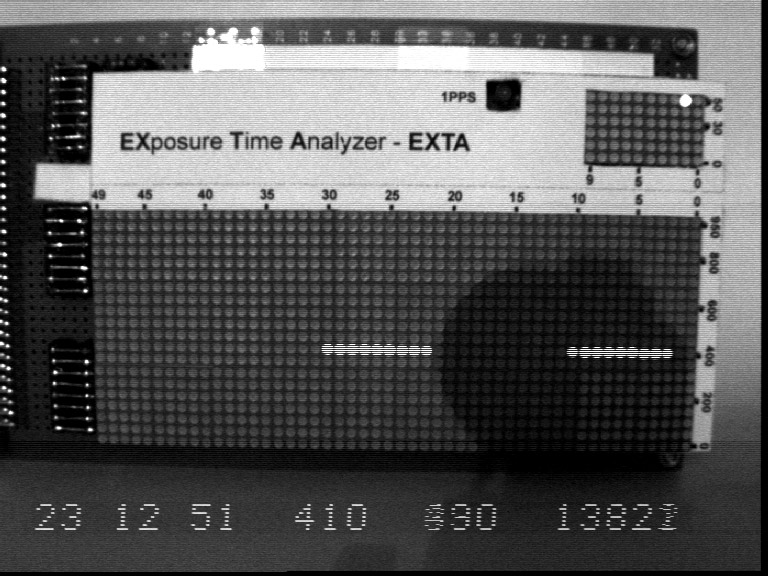
The exposure of the image above started and ended in UTC second 51. The camera WAT-902H2 Ultimate was set manually to a shortened exposure duration of 1/120s. This means that the camera exposured only the last 8.333ms of normal 20ms in boths video fields of the video frame. So both lit LED rows which we can see in the image are the end of every video field. EXTA was set to mode 0 so every LED in the big LED matrix corresponds to 1ms. Every row shows 9 lit LEDs. This is because both exposure durations were 8.333ms and so a little bit longer than 8ms. With this knowledge we can determine now the video frame start and end times. The frame start was in the 391th millisecond and the end in the 431st millisecond. The two exposure time windows were 51.402 - 51.410 and 51.422 - 51.430.
The same video image from a shortened exposure of 1/120s split in both fields
CCIR video image with KIWI-OSD video time insertion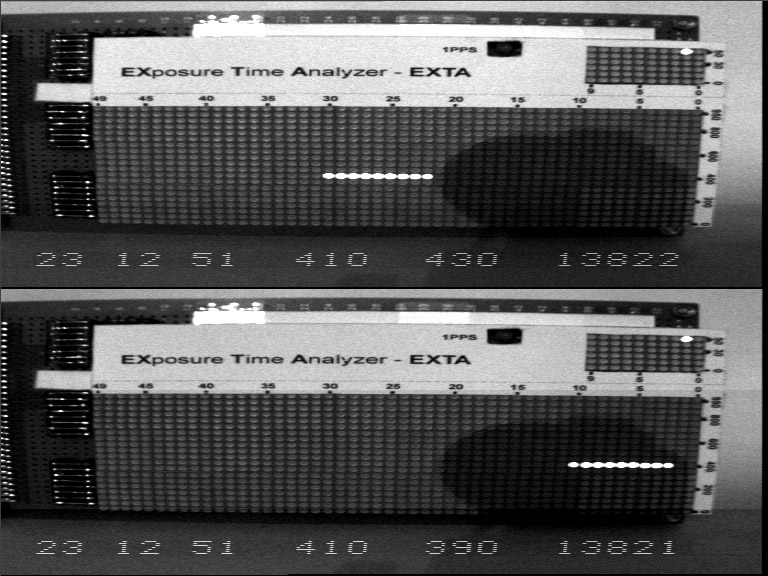
Now both fields are also clear visible. The first field #13821 is exposured from 51.402 - 51.410 and the second field #13822 from 51.422 - 51.430. Of course the same result as seen in the frame image above. If we compare the frame start and end times measured by EXTA and the times inserted by the Video Time Inserter KIWI-OSD on the image bottom we can see a difference of about one millisecond. The answer is again a time shifted output signal of the video camera. The start of the optical exposure is nearly one millisecond late to the output signal of the previous field with Vsync. And because this VTI and most others too are time stamping the video fields triggered by the Vsync we get times shifted by nearly one millisecond. So this time shift is not caused by the VTI device and was also measured by me with my other measurement device VEXA some years ago. But this relative small time shift is absolutely no problem in normal occultation work.
Full frame video image from a shortened exposure of 1/250s
CCIR video image with KIWI-OSD video time insertion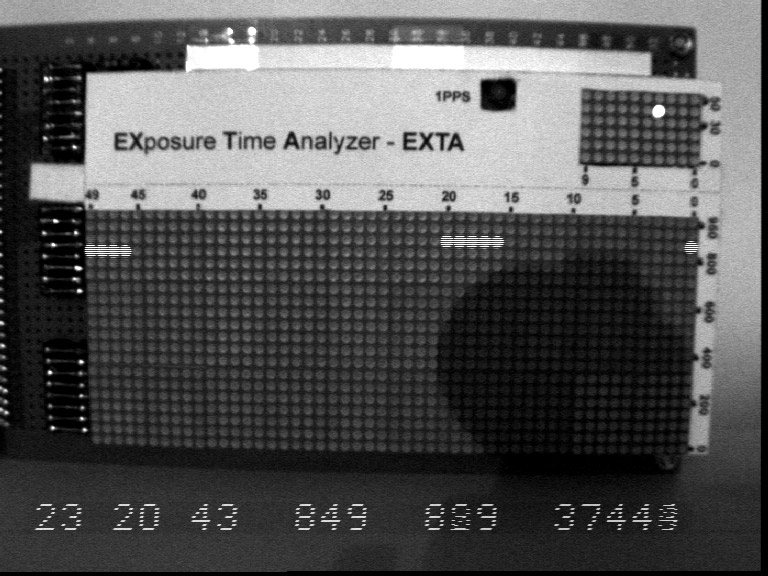
The exposure of the image above started and ended in UTC second 43. The camera WAT-902H2 Ultimate was set manually to a shortened exposure duration of 1/250s. This means that the camera exposured only the last 4ms of normal 20ms in boths video fields of the video frame. So both lit LED rows which we can see in the image are the end of every video field. EXTA was set to mode 0 so every LED in the big LED matrix corresponds to 1ms. Every row shows 5 lit LEDs. This is because both exposures did not start exactly with a start of a new UTC millisecond. A shift in time leads to a partial lit LED at the start and also at the end of every exposure. With this knowledge we can determine now the video frame start and end times. The frame start was somewhere in the 830th millisecond and the frame end somewhere in the 870th millisecond.
The same video image from a shortened exposure of 1/250s split in both fields
CCIR video image with KIWI-OSD video time insertion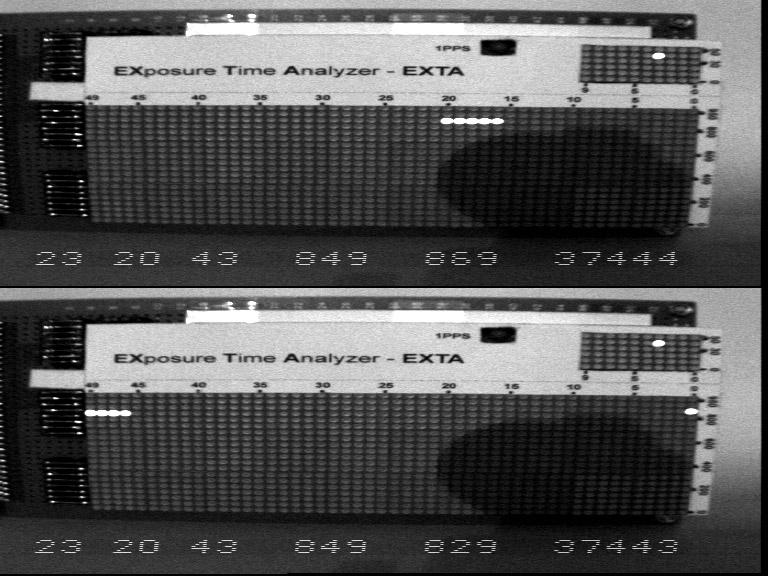
Now both fields are also clear visible. The first field #37443 is exposured from 43.846 - 43.850 and the second field #37444 from 43.866 - 43.870. If we compare the frame start and end times measured by EXTA and the times inserted by the Video Time Inserter KIWI-OSD on the image bottom we can see a difference of about one millisecond. The answer is again a time shifted output signal of the video camera. The start of the optical exposure is nearly one millisecond late to the output signal of the previous field with Vsync. And because this VTI and most others too are time stamping the video fields triggered by the Vsync we get times shifted by nearly one millisecond. So this time shift is not caused by the VTI device and was also measured by me with my other measurement device VEXA some years ago. But this relative small time shift is absolutely no problem in normal occultation work.
Pages of the EXTA project
Page #1 - Main page with EXTA description
Page #2 - Measurements with analog video camera modul SK1004XC
Page #3 - Measurements with analog video camera WAT-902H2 Ultimate (this page)
Page #4 - Measurements with integrating analog video camera WAT-120N
Page #5 - Measurements with Astro CCD camera Atik 314L+
Page #6 - Measurements with IOTA-VTI device
Page #7 - Measurements with integrating analog video camera MINTRON 12V1C-EX
October 10, 2012 |
|
Site Home |